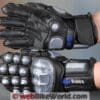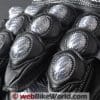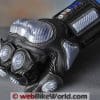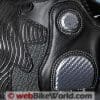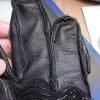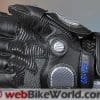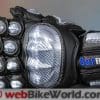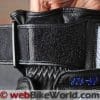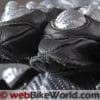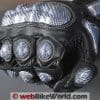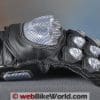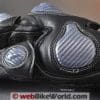The new SāFRāce SR-182 motorcycle gloves have several interesting and unique protective features. They look rugged, they feel tough and they’re actually pretty comfortable. The word “SāFRāce” was designed as a catchy marketing phrase for the glove brand. I had to search through the Unicode character map to find the “ā” HTML code (ā) for “long a”.
I’m not sure if the search engines will take kindly to that and I’m not about to manually enter the escape code twice for each, so from here on out it’s “SaFRace”. At least you know how to pronounce it…
The SaFRace SR-128 gloves were designed by an ex-motorcycle racer who couldn’t find a pair of gloves that would meet his specifications. After racing (and crashing) with many different pairs and suffering a variety of hand injuries in the process, the search was on. Gloves from all of the major manufacturers were purchased, dissembled and studied, as were the worn-out and crashed gloves from his collection and from other racers.
Many prototypes were made and tested (thus the “128” in the name) to develop what is now knows as the SaFRace SR-128 gloves. So what makes this design better? It’s always difficult to determine which safety features provide the optimal protection in a pair of motorcycle gloves. Not to mention that the quality of the ingredients and the construction techniques play a big role in how the glove will hold up in a crash. Also, in the absence of any formal lab test reports, a motorcyclist can only go by a subjective analysis of the ingredients to determine the level of protection a pair of gloves might provide.
But subjectivity isn’t to be completely dismissed, and our experience with reviewing many, many pairs of motorcycle gloves over the years at least provides a good database of knowledge that indicates what to look for. Plumbing the depths of that knowledge indicates that the SaFRace SR-128 gloves light up all the buttons when it comes to protection. Let’s take a look…
SaFRaceSR-182 Gloves
The SaFRace SR-128 gloves are about as rugged-looking as you’ll find, although the post-apocalyptic styling is reminiscent of the Velocity Gear SS Metalwear gloves (review) we reviewed back in 2007. Remember them? Stainless steel knuckle protectors and styling that seemed way out there. But hey — when the Mayan zombies attack on December 21, 2012, they’re the gloves to have!
Riding a motorcycle uncovers a couple of problems with using stainless steel plates for the knuckle protectors, however. First, it’s more difficult to mold stainless plate to fit over the knuckles. And it obviously doesn’t flex (which is both a pro and con). But the biggest issue is how the plates are attached to the leather body of the gloves.
Since stainless steel plate can’t be sewn on to the leather, large rivets are used instead. Large rivets means large holes in the leather and large holes can mean a potential weakening of the leather just where you need it the most. All this is theoretical, by the way, but there’s probably a reason why the stainless steel plate knuckle protector concept never really caught on.
The “Valentino Rossi” (or Casey Stoner, or…) test comes into play here: if it’s good enough for Rossi, it’s good enough for me. I haven’t seen Rossi or Stoner or any other MotoGP or World Superbike racer wearing gloves with stainless steel knuckle protectors and there must be a reason for that.
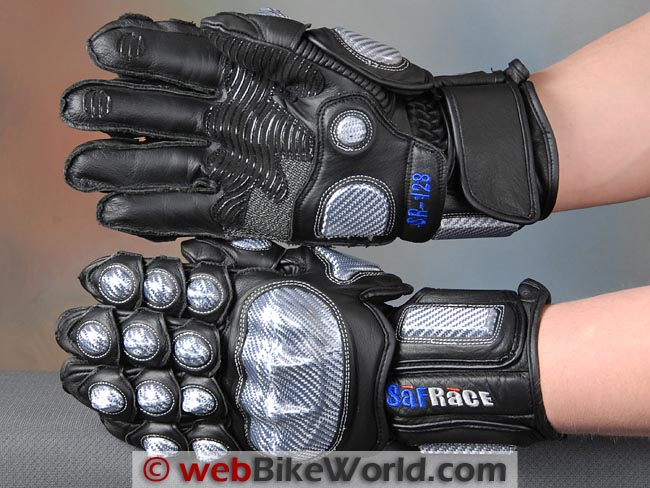

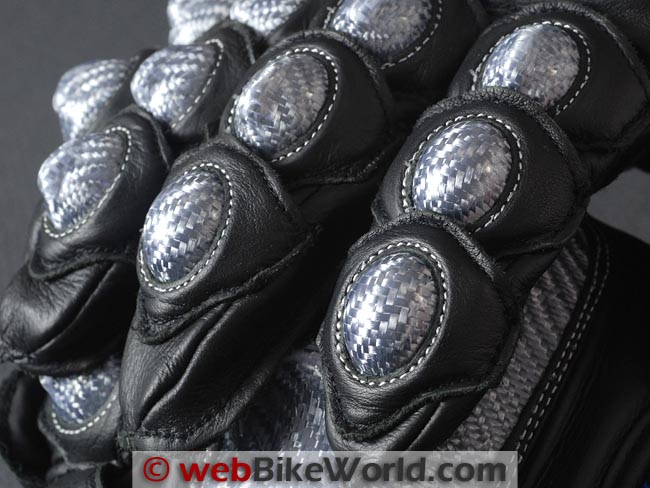

The Texalium Difference
The first thing you notice about the SaFRace SR-128 gloves is the massive amount of silvery-looking surface area devoted to the knuckle protectors and sliders.
If this protective material appears different, that’s because it is. Much of the SaFRace prototype testing was devoted to finding the best material to use for knuckle protection.
SaFRace ended up choosing “Texalium”, a sort of carbon fiber/aluminum/fiberglass composite weave.
SaFRace said they quickly discounted “normal” carbon fiber when it was discovered that the material was too prone to cracking and splintering, which was apparent on the crashed gloves they had collected.
Carbon fiber is strong stuff for its weight in some ways, but it can be brittle.
The company tested various combinations in a hydraulic press to measure impact strength, and Texalium was found to be more forgiving and “flexible” in an impact than carbon fiber but stronger than fiberglass alone — a nice compromise.
Texalium was invented by Hexcel, a company that specializes in carbon fiber and composites for the aircraft industry and others.
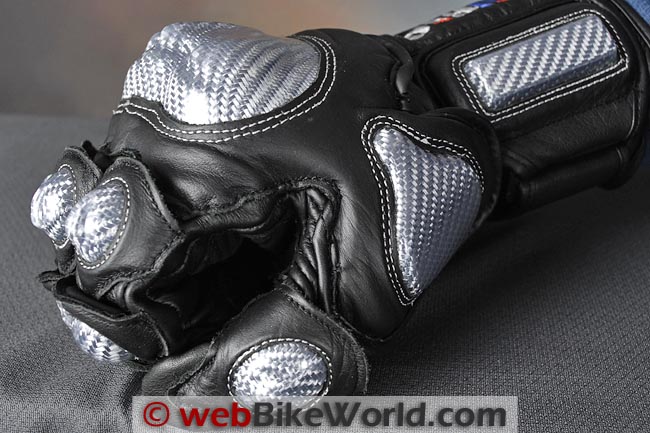

Texalium Knuckle Protectors
It’s also my understanding that Texalium can be more difficult to mold into complex shapes, but the end results are worth the effort. The knuckle protectors on the SR-128 gloves are shaped differently than on other gloves.
The huge main knuckle protector covers nearly the entire back of the hand when the hand is in a fist, and the Texalium is formed into what can only be described as creases above the main curvature.
SaFRace said they made the main knuckle protector extra large to protect the entire top of the hand, including the fifth metacarpal — the “pinky” finger.
The middle knuckle on the second finger, along with the middle and top knuckles on the third and fourth fingers, have large sections of Texalium formed into the protector.
But the SR-128 gloves go one more and add a matching section of Texalium over the bone between the middle and base knuckle.
That’s why you see three protectors on each finger (except the fourth “pinky” finger) on the SR-128 gloves.
Texalium is also used in a big protector over the outside of the thumb, protecting that large knuckle and another Texalium protector covers the middle knuckle of the thumb.
Two more rectangular sections of Texalium cover the outside of the wrist with another rectangular section on the inside.
And finally, there’s a circular Texalium protector covering the bottom of the thumb on the palm side, along with a large semi-square section protecting the “heel” of the hand.
All told, there are 19 (count ’em) sections of Texalium strategically located all around the gloves. I’m not sure you could fit any more without making the gloves entirely out of the stuff, but then they’d be useless as motorcycle gloves.
What’s amazing is that even with all this protection, the SR-128 gloves remain flexible and comfortable.
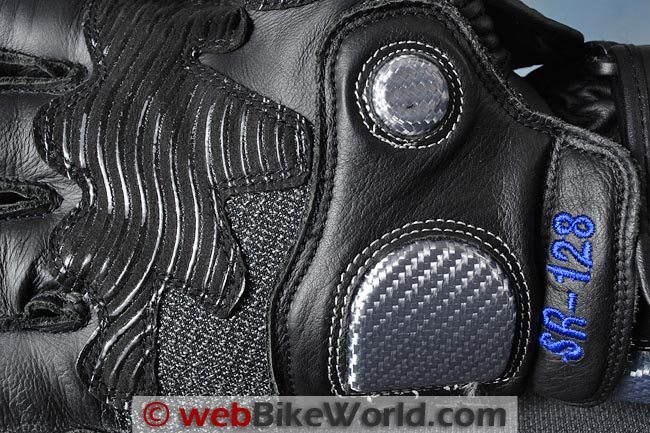

Padding and Liner Material
The huge amount of surface area covered by the Texalium protectors on the SR-128 gloves required a corresponding amount of padding underneath or the gloves would be too stiff for motorcycle riding (although perhaps just right for cuffing zombies!).
Underneath each of the protectors lives a variety of “high impact” padding in different thicknesses — some of it is up to a claimed 15 mm thick.
We did not disassemble an SR-128, but the main knuckle protector has a correspondingly big, thick section of padding underneath that’s so thick, the underside of the knuckle protector can’t be felt, even when squeezing the inside of the gloves.
Although this method creates some seams inside the gloves, they aren’t obvious when wearing the gloves.
The liner material is also soft and apparently has a layer of padding just underneath, which makes the gloves feel comfortable inside; probably more comfortable than many other “race” gloves.
Joint Articulation and Flexibility
Each of the knuckle protectors on the fingers is also backed by thick sections of padding and the protectors float on separate pieces of leather, which provide the needed flexibility plus an additional level of abrasion protection.
The single-row stitching that attaches the Texalium on the floating knuckle protector covers on the outside is very precise and the main knuckle protector and the Texalium elsewhere on the gloves are attached with double rows of stitching.
The entire large main knuckle protector and the protectors that cover the outside of the thumb base are all on one single piece of leather that floats above the main body of the glove.
It’s attached at one point between the forefinger and thumb to prevent movement but otherwise it’s one piece with heavy padding underneath.
This design is also different from most of the other race gloves designs we’ve reviewed.
Abrasion Protection
Although the Texalium protectors represent the most distinguishing characteristic of the SR-128 gloves, SaFRace also added several layers of abrasion protection for good measure.
In fact, the company claims five different layers of protection are used in the gloves, including good ol’ leather and the motorcyclist’s friend, Kevlar.
The large Texalium palm sliders on the heel of the hand are double-stitched on to a separate section of leather, so there’s two.
A separate section of Kevlar covers the entire outside half of the palm and runs underneath the leather holding the palm sliders, so that makes three.
The leather glove body lives underneath those three, making four. And the upper part of the palm has a large silicone-impregnated patch that makes five and gives the gloves some grip stiction.
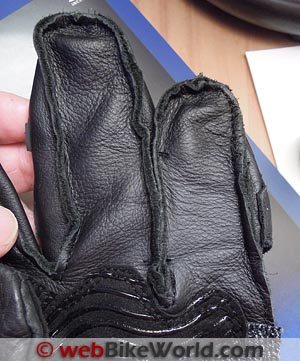


That silicone-striped material covers the underside of the thumb also for good measure.
The leather used throughout the SR-128 gloves is from those poor old cows. It feels thick and it’s nice and soft, which also gives added flexibility to the gloves.
Finger Construction
One more feature of the SR-128 sometimes found on full race gloves is the attached third and fourth fingers.
This helps keep the pinky finger from rolling under in a crash by adding support from the third finger.
This feature is so subtle on the SR-128 gloves that neither of us noticed it after first photographing the gloves and then wearing the gloves on several rides.
It does not interfere at all with normal operation of the controls.
The fingers are constructed in what I think is called the fourchette style, with exposed seams, flat bottom under the fingers and tapered fingertips with the sides and tops of the fingers meeting at a point along the fingertip.
The exposed seams makes the fingers slightly wider than they would be with hidden seams, but the upside of this type of construction is that the fingers are smoother on the inside without the internal seams, which can give a better feel for the grips when racing.
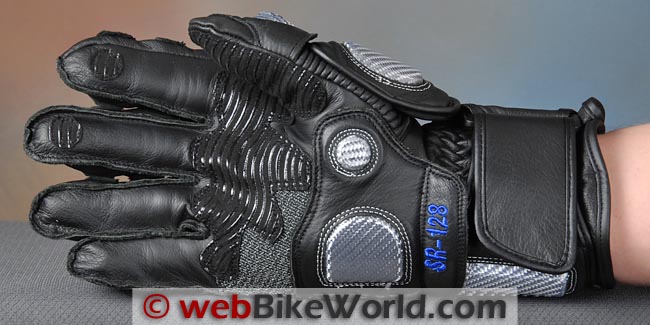

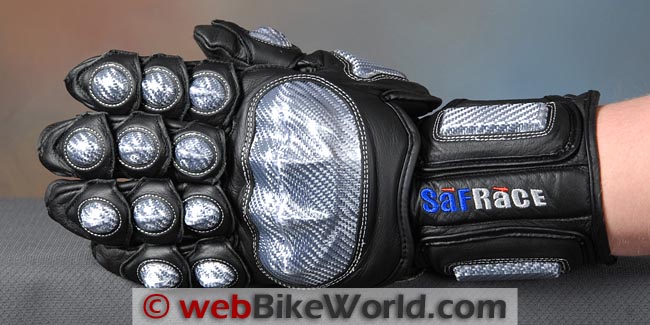

Sizing and Fit
We normally order a size large in motorcycle gloves because this size coincidentally will fit any of the evaluators who help with the webBikeWorld reviews.
But the size large SR-128 gloves seemed a bit large and more like an XL. The internal fit (width) felt a little looser than expected for race gloves and the fingers were longer than a standard size large.
SaFRace then sent a size medium, which fits more like a standard size large.
But the thumb feels slightly short and the proportions of the hand over the palm in the length from the heel of the hand to the web between the fingers feels a touch short.
The SR-128 gloves are currently available only in sizes M or L; apparently the proportions of the large protectors and sliders would have to be reduced for smaller sized gloves, which would then involve new molds for the Texalium.
The fingers feel wider than average and we’d guess that the width is necessary to fit the large diameter Texalium protectors over the top.
The external seams add a bit of width, so the SR-128 gloves do fit and feel a little different than some other race gloves we’ve tried.
But the soft leather doesn’t require much break-in and the generous padding on the inside helps to keep things comfortable.
The only issue we have with the size medium gloves is the Texalium protector over the outer thumb knuckle, which doesn’t quite have enough flexibility when the hands are tightened around the grips.
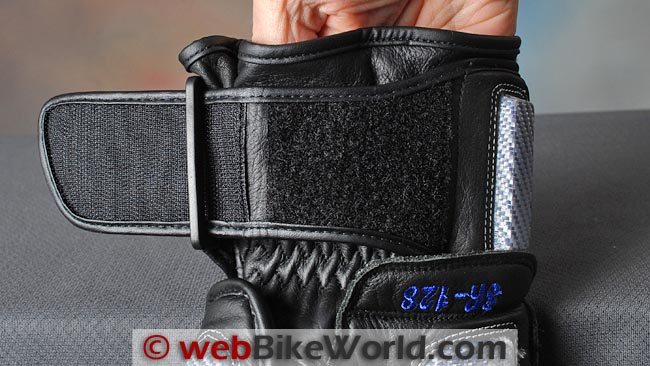

Gauntlet
We measure it as about 130 mm (5″) on the size large gloves when fully expanded.
Also, the narrow and snug-fitting gauntlet fits tight enough to preclude the use of a secondary wrist closure, which helps to trim up the fit.
The gauntlet has a wide hook-and-loop strap that fits under an equally wide plastic “D” ring that is captured under the extra section of leather that holds the Texalium wrist slider on the inside of the wrist.
The closure strap could be about another 30 mm or so longer, as it just barely fits over the gauntlet and cuff when the sleeve is covered.
It could be possible that the SR-128 gloves are designed to fit under the sleeve cuff, but we don’t think so, as the three large Texalium wrist sliders add too much thickness for that.
So our wish would be to increase the length of the gauntlet in the rear by about 60 mm; to increase the width of the gauntlet by another 40 mm or so; and to increase the length of the hook-and-loop strap by another 30 mm or so.
Increasing the length of the strap would mean reducing the size of the Texalium slider on the lower part of the outside of the wrist, but perhaps the two sliders could be reduced to one to make up the difference.
As it is, the SR-128 gloves can be a difficult fit over a winter street jacket with an insulated liner.
But, it could be argued that these are no-compromise race gloves that would be worn only over leathers. That would be limiting the market though…perhaps SaFRace should make a sport touring version of the gloves?
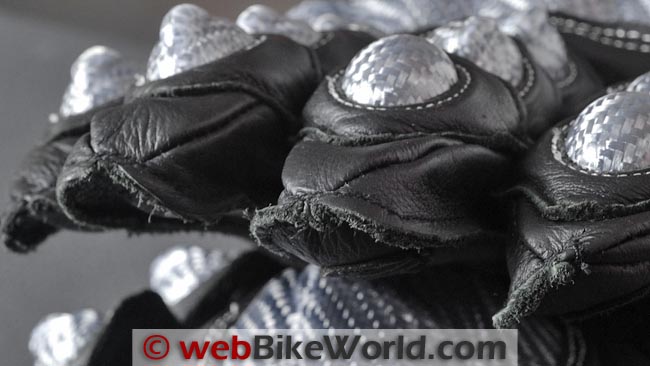

Ventilation
The winter weather has been much milder than average here, with a few recent days actually reaching the 60+ degree F region.
While not warm enough to evaluate the heat retention of the SR-128 gloves, there are no problems to report and the gloves feel neutral so far for both heat and cold.
Again, these are designed as race gloves and any perforations added for ventilation could only increase the probability of tearing or weakness in the glove body, thus the compromise.
Conclusion
The SaFRace SR-128 gloves are rugged-looking “all business” with many protective features.
The huge sections of Texalium knuckle protectors and sliders are their distinguishing characteristic, but several other abrasion protection features and extra layers of material, along with very thick internal padding on the back of the hands, gives these gloves excellent potential for crash protection.
The fit may be a bit of an issue and we’d like to see a larger gauntlet, which could fit a wider variety of motorcycle clothing.
But there’s no doubt that the design of the SaFRace SR-128 gloves has been carefully considered and the gloves have the potential of offering more protection than many other full race motorcycle gloves.
Owner Comments and Feedback
See details on submitting comments.


